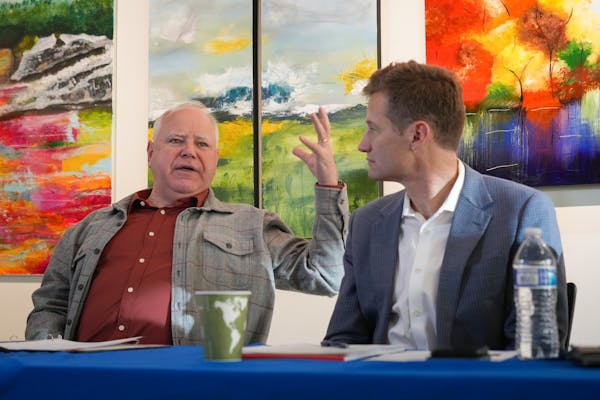Every morning, Mary Solheim looks forward to seeing the children at Playschool Child Care in Maplewood, where she works as the director. But in recent years, the joy of the work has been tempered by worry about what will happen if too many of her staff are out.
State-mandated staffing ratios, which limit the number of children each staffer can care for, are serious business, Solheim said. It's rare, but occasionally she has to close classrooms, and families have to make other child-care arrangements for a day. But for any child care in the state, being out-of-ratio — because not enough staffers show up for work, or because there aren't enough people to fill jobs in the first place — means risking license violations. Too many violations, and a child care could be forced to close.
"It's always a 'what-if' game," Solheim said. "That makes it very difficult."
Child-care providers and advocates in the field see staffing ratios as a protection for safe and high-quality early-childhood education. Still, when providers are caught between a staff shortage and families' need for care, hard choices must be made.
If a staffer is out, sometimes ratios can be maintained by shuffling students between classrooms. Solheim and other child-care directors find themselves in a classroom more often than they'd like, working 10 or 12 hours with children before returning to administrative work. On occasion, centers have to send children home.
Mother of three Ishia Lee of North St. Paul said having reliable care lets her keep her job at a call center. It's hard to find care anywhere, she said, and particularly tough to find someone who can work with her son's special needs.
Finding a good fit at Playschool has made a huge difference for her family, Lee said.
"They were willing to go the extra mile," she said.
When the Primrose School in Maple Grove is short-staffed, owner Joe Piket knows some parents are able to keep their children home for the day without too many problems.
But not all families can change their schedules on a moment's notice, he said, and there are plenty of centers serving parents who truly cannot call out from work. Those centers may take the risk of running without enough staff.
"Most of us try to operate legally where we can," he said.
More than 5%, or about 600, of Minnesota's 12,000 child-care providers have had to close at least once in the past two years, according to a 2022 survey conducted by the Federal Reserve Bank of Minneapolis. Over half of child care-centers surveyed said trouble hiring meant they could not take on more children.
"I've been concerned for some time about how the workforce shortage in our child-care workforce is going to start showing up in citations," said Clare Sanford of the Minnesota Child Care Association, an industry advocacy group.
Marginal fixes
State regulators aren't playing 'gotcha,' Sanford said. But they can't ignore when a center has too many children and not enough teachers.
"That really is a symptom of the true workforce crisis that we're in," she said. "They're showing up for their annual licensing visits and that's what they're finding."
For the most part, state licensing in the Department of Human Services has been helpful, Sanford said — for example, expediting the licensing waivers that allow providers who don't yet have the credentials to work as teachers to substitute prior experience for more education.
In addition, more competitive pay and advancement opportunities seem to make some centers attractive to people who want to work in the field, said Morgan McPartland of Language of Love Spanish Immersion child care and preschool in Eden Prairie.
"It's tough to find people who really, really want to work with children," McPartland said. "But it's been getting better."
Social ties help, too. McPartland said Language of Love's owners' church network has helped attract a steady stream of applicants. At North Heights Christian Preschool in Roseville, director Julie Beguhl said an association with the North Heights Christian K-8 school has attracted parents to work at the preschool, in some cases even after their children start kindergarten.
Not rebounding enough
Though the industry is beginning to make up for what was lost at the height of the COVID-19 pandemic, longer-term trends spell trouble. The number of licensed child-care facilities has been dropping every year since 2003, according to state data.
Nate Lassen of St. Louis Park drove half an hour to Playschool in Maplewood on Friday — the most affordable place he could find for his two school-aged children, he said.
"Every time I see a young family, I'm like, 'Good luck,'" he said. "I don't know how people can afford five, six hundred bucks a week for two kids."
Efforts are underway at the State Capitol this session to expand the child and dependent care tax credit to help families with child-care costs, as well as to change licensing requirements to qualify more child-care workers.
The Minnesota Child Care Association wants to see care for elders or people with disabilities counted toward experience needed for child-care credentials, and for experience to be automatically counted as a substitute for credentials instead of requiring waivers that are nearly always granted.
Sanford said those changes will be helpful, but won't immediately fix the workforce shortage in early-childhood education. As things stand now, she said, centers generally aren't able to pay teachers competitively without drastically raising prices for parents.
"We cannot keep going the way we have been," she said.
Carolyn Parnell, 'trailblazer' who served as Minnesota's first IT commissioner, dies


